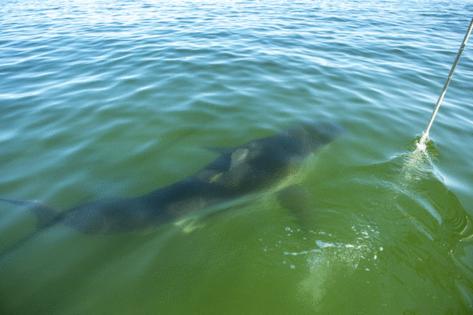Former shark fishermen now work to protect the animal. A university shark expert helps
Published in Lifestyles
They hesitated at first, but the fishermen jumped into the water after realizing how calm the tiger sharks were, said Chelsea Black.
Black, a postdoctoral researcher at UNC-Chapel Hill, spent two weeks at sea, teaching shark fishermen how to tag and release the animals rather than kill them.
Black partners with Project Hiu, a nonprofit organization in Indonesia, to educate locals on shark conservation while giving them an alternative income source.
“Whether you’re in North Carolina or you’re in Indonesia, sharks are important to you,” she explained. “The health of shark populations contributes to the health of our oceans.”
Why do we need sharks?
Sharks live all over the world, and several species visit North Carolina each summer. UNC has the longest-running shark survey in the country, managed by its Institute of Marine Sciences in Morehead City, North Carolina.
These top predators eat smaller animals, balancing the populations of fish and other marine life. For example, sharks protect coral reefs by eating fish that graze on coral. Without sharks, these fish would overpopulate and destroy the coral reefs that protect beaches from storms.
“Many people, especially in coastal areas like North Carolina, rely on a healthy ocean ecosystem for our economy, business and food,” Black said.
However, the population of many shark species has declined over the past 50 years.
Increased demand for shark and their products has contributed to this decline, according to the National Oceanic and Atmospheric Administration.
Catching sharks to make money off of them is known as commercial shark fishing. Shark fins, in particular, are highly profitable.
“They’re being fished and killed before they can reproduce ... killing the next generation of sharks,” Black said.
Indonesia sits between the Indian and Pacific oceans and is home to hundreds of shark species. It is also one of the largest shark fishing nations in the world.
To counteract this, Project Hiu hires fisherman to provide shark-friendly tourism activities, such as swimming with sharks. Project founder Madison Stewart repurposed a fleet of shark fishing vessels for the ecotourism business.
After noticing that fishermen were primarily catching tiger sharks during September and October, Stewart invited Black to come to Indonesia and start a satellite research project tagging tiger sharks.
The team discovered a tiger shark hot spot
Tiger sharks are named for the dark vertical strips on the side of their body. Averaging 10 to 14 feet and 850 to 1,400 lbs., they are one of the largest shark species.
The team studies tiger sharks because they are fished less due to their low fin value. This increases their odds of surviving long enough to provide helpful information.
Tagging these sharks is a team effort, with two or three people in the water, Black leaning over the side of the boat and others assisting.
First, the team flips the shark upside down, putting it in a trance to safely take measurements that help the team ascertain its age and health. A fin-clip sample helps trace a shark’s ancestry and what part of the world they come from.
Then, they flip the shark right side up to place tags on the shark’s dorsal, or top, fin. These tags show how far and/or deep the sharks are moving, revealing the shark’s migration patterns, she said.
Once the sharks are tagged, they are named and released. Most are named after the fishermen’s children.
The team has now deployed 10 tags and discovered a tiger shark hot spot.
“We found they’re all staying in one small area for months, and we only have a few cases of this around the world,” Black said.
The team still has a lot to uncover, however, as they are the first to tag tiger sharks in Indonesia. Black will return in September, adding 15 more tags, to better understand when the sharks are gathering and why.
The goal is to show that making the hot spot a government-protected area could potentially help multiple sharks species , Black explained.
It’s feasible, she added, considering the hot spot is “probably 40 square kilometers” which is “not very big in terms of the ocean.”
Potential protections could cover all or certain species of sharks for parts or the whole year, depending on migration patterns.
Without this protection, Black fears certain species will go extinct in this region. The loss of shark populations in Indonesia could have ripple effects all over the world.
“It’s kind of this chain reaction,” she said. “We need to care about these things happening in the ocean across the world because it impacts every single person living on Earth.”
For more information about the project, go to www.projecthiu.com/
©2025 The News & Observer. Visit at newsobserver.com. Distributed at Tribune Content Agency, LLC.
























Comments